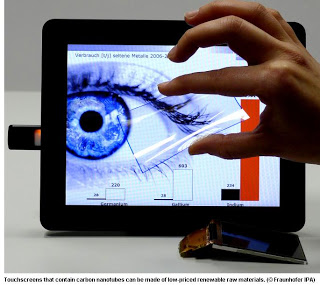Researchers at Fraunhofer have come up with an alternative display made of low-priced renewable raw materials available all over the world. The researchers are presenting touchscreens that contain carbon nanotubes at the nano tech 2011 fair in Tokyo (Hall 5, Stand E-18-11) from February 16-18.
The researchers at Fraunhofer have succeeded at coming up with a new material for electrodes that is on the same level as indium-tin-oxide (ITO) and on top of it is much cheaper. Its main components are carbon nanotubes and low-cost polymers. This new electrode foil is composed of two layers. One is the carrier, a thin foil made of inexpensive polyethylenterephthalate PET used for making plastic bottles. Then a mixture of carbon-nanotubes and electrically conducting polymers is added that is applied to the PET as a solution and forms a thin film when it dries.
In comparison to ITO, these combinations of plastics have not been particularly durable because humidity, pressure or UV light put a strain on the polymers. The layers became brittle and broke down. Only carbon nanotubes have made them stable. The carbon nanotubes harden on the PET to create a network where the electrically conducting polymers can be firmly anchored. That means that this layer is durable in the long run. Ivica Kolaric, project manager from Fraunhofer Institute for Manufacturing Engineering and Automation IPA, concedes that “the electrical resistance of our layer is somewhat greater than that of the ITO, but it’s easily enough for an application in electrical systems.” Its merits are unbeatable: carbon is not only low-cost and available all over the world. It is also a renewable resource that you can get from organic matter such as wood. Kolaric and his colleagues will be presenting their carbon touchdisplay at the 2011 nano tech fair. Since 2003 Fraunhofer researchers show their developments at the annual trade show.
There are a whole series of implementations for the new technology. This foil is flexible and can be used in a variety of ways. Kolaric sums up by saying “we could even make photovoltaic foils out of it to line corrugated roofs or other uneven structures.” The researcher has already set up pilot production where the foil can be enhanced for a wide range of applications.
If you liked this article, please give it a quick review on ycombinator or StumbleUpon. Thanks

Brian Wang is a Futurist Thought Leader and a popular Science blogger with 1 million readers per month. His blog Nextbigfuture.com is ranked #1 Science News Blog. It covers many disruptive technology and trends including Space, Robotics, Artificial Intelligence, Medicine, Anti-aging Biotechnology, and Nanotechnology.
Known for identifying cutting edge technologies, he is currently a Co-Founder of a startup and fundraiser for high potential early-stage companies. He is the Head of Research for Allocations for deep technology investments and an Angel Investor at Space Angels.
A frequent speaker at corporations, he has been a TEDx speaker, a Singularity University speaker and guest at numerous interviews for radio and podcasts. He is open to public speaking and advising engagements.


